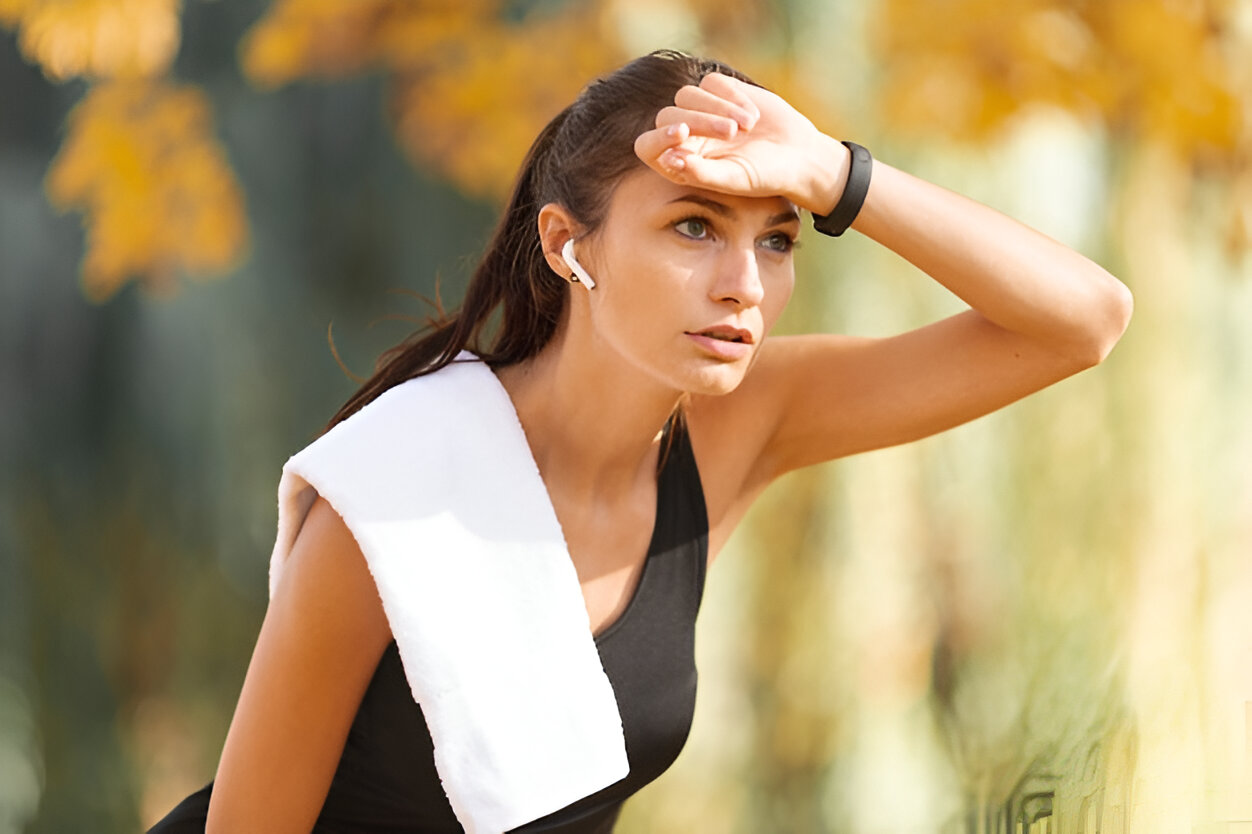Dubai’s heat can make any workout feel harder than it needs to be. When temperatures rise, your clothes affect how you feel and perform. Thick or non-breathable fabrics trap heat, make you sweat more, and can cause skin irritation. On the other hand, breathable and moisture-wicking clothes help your body stay cooler and more comfortable. If you’re training outdoors or even indoors without strong air conditioning, fabric choice matters. Wearing exercise-friendly fabrics that work for Dubai’s climate helps you manage sweat, reduce discomfort, and focus on your workout instead of the heat.
Top Features to Look For in Hot-Weather Workout Clothes
Choosing the right workout gear in the UAE isn’t just about style—it affects how long and how well you train. You can tailor training to weather conditions by adjusting both your workout timing and your clothing. Early mornings or late evenings help you avoid peak heat, but fabric features also play a big part.
For instance, breathable materials allow airflow and help release body heat, which keeps you cooler during exercise. Moisture-wicking fabrics pull sweat away from your skin, helping reduce stickiness and irritation. Quick-drying options cut down the chance of chafing, especially during high-intensity sessions. Also, lightweight clothes feel less restrictive and won’t weigh you down as the heat rises.
For outdoor workouts, fabrics with UV protection help block harsh sun exposure. Stretchy materials also support movement, so your clothes move with you, not against you. Combining smart timing with the right clothing helps you stay comfortable and push through tough workouts, even in extreme heat.
Exercise-Friendly Fabrics That Work for Dubai’s Climate
Not all fabrics perform well in extreme heat. If you’re training in Dubai, you need clothing that helps manage sweat, supports airflow, and stays comfortable no matter the temperature. The following exercise-friendly fabrics that work for Dubai’s climate can help you stay cooler and more focused.
Polyester Blends: Lightweight and Reliable
Polyester is one of the most common choices for activewear. It’s lightweight, dries fast, and doesn’t soak up sweat like cotton. When blended with spandex or elastane, it also offers good stretch, which adds comfort during movement. These blends hold their shape and don’t feel heavy even after long workouts.
Nylon: Smooth and Quick-Drying
Nylon feels soft on the skin and dries quickly, which helps prevent chafing. It resists abrasions and lasts longer, even after many washes. Many gym shirts, leggings, and sports bras use nylon for these reasons. It also stretches well, making it a solid choice for both high-intensity and low-impact training.
Bamboo: Soft and Breathable
Bamboo fabric is growing in popularity for hot-weather training. It feels soft, breathes well, and fights odor naturally. Research supports its benefits. A 2015 study on cyclists posted by Research Gate found that shirts made of 100% bamboo kept core temperature and perceived effort lower during exercise in hot and humid conditions (32°C, 75% RH). That makes bamboo a strong choice if you’re doing light workouts or stretching routines in the heat. Plus, it works well for people with sensitive skin because the fibers feel silky rather than rough. Overall, bamboo offers comfort, breathability, and odor control, which are key for training in Dubai’s climate.
Merino Wool: Natural Temperature Control
Though it sounds like a winter fabric, Merino wool also works in hot weather. It helps regulate body temperature and wicks moisture away without holding onto odor. Some trainers use Merino for outdoor runs or hikes in dry heat. It doesn’t trap heat the way other wool types do.
Avoid Cotton in Extreme Heat
Cotton feels soft, but it holds sweat and dries slowly. Dubai’s climate leads to discomfort and heavy, wet clothes. If you wear cotton during workouts, you may feel hotter, especially during long sessions. Save cotton for cooling down, not for active training.
Tips to Stay Cool While Training Outdoors
Training outdoors in Dubai requires more than just motivation—you need a plan to manage the heat. Small changes in your routine can help you stay safe, focused, and productive during workouts. Beyond choosing the right clothes, think about how you prepare, what you eat, and when you exercise. Here are some practical tips to help you stay cool:
- Train early or late – Avoid the midday sun by exercising before 9 a.m. or after sunset—heat peaks between noon and 4 p.m.
- Wear light-colored, breathable clothing – Light shades reflect sunlight, and breathable fabrics help your skin stay dry.
- Choose loose fits – Tight clothes trap heat and reduce airflow. Loose styles allow better movement and cooling.
- Bring a cooling towel or wear a sweatband – These help keep sweat out of your eyes and lower your body temperature.
- Use sunscreen – Reapply every 90 minutes, especially during long outdoor sessions.
- Follow a hydration routine – Drink water before, during, and after your workout. Add electrolytes if you’re sweating a lot.
- Keep your meals light – Heavy foods make digestion slower and raise body temperature. Go for salads, smoothies, or lean proteins before training.
- Prep meal plans for recovery – After workouts, eat meals that support hydration and muscle recovery. Include watermelon, cucumber, yogurt, or grilled chicken.
- Watch the signs – If you feel dizzy or overly tired, stop and find shade. It’s better to pause than push too hard.
How to Wash and Care for Your Hot-Weather Gear
Washing your hot-weather workout clothes the right way helps them last longer and perform better. To protect fabric strength and shape, use cold water instead of hot. Hot water can break down the stretch and reduce breathability over time. In addition, avoid fabric softeners, as they leave a coating that blocks moisture-wicking functions.
If your clothes still smell after washing, soak them in a mix of water and white vinegar before the next cycle. That helps remove odor without damaging the fabric. Always check the care label, especially on bamboo or merino pieces, since some materials need extra attention.
After washing, air-dry your gear whenever possible. The high heat from dryers can shrink or weaken the fabric. However, if you need to use a dryer, choose a low-heat setting to reduce damage. Lastly, wash your gear after each workout to prevent bacteria buildup and keep everything fresh. By following these steps, you help your clothes stay comfortable, functional, and ready for your next session in the heat.
Train Smarter, Dress Cooler
Choosing exercise-friendly fabrics that work for Dubai’s climate helps you stay focused, dry, and more comfortable during workouts. When you pair the right clothes with smart habits—like proper timing, hydration, and recovery—you protect your energy and performance. Dubai’s heat doesn’t have to slow you down if you dress for it and train with purpose.
Want to know about ‘Meal Plans for Athletes‘? Check out our ‘Blog‘ category.



